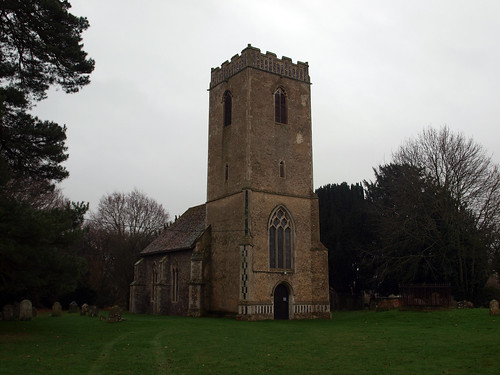That said I loved the exterior, the lovely churchyard and its stunning location.
OLD ST ANDREW. Dec W tower with flushwork decoration on base, buttresses, and battlements. The W window has reticulated tracery. Nave only, with a small C19 apse. - BRASSES. Ecclesiastic, Civilian, and Lady, all of c 1430, all c. 2 ft 6 in. figures (NW corner).
MELTON. Its long street joins Woodbridge, but it has its own history and some ancient houses. Here is an ancient gaol now used for housing goods; the governor’s house has old oak beams and windows from which the governor could see the gabled roof of the gaol. In this old prison two heroes of Melton were held captive, Alice Driver and Alexander Gouche, both burned at Ipswich in the terrible days of Mary Tudor. They were found hiding in a haystack and poked out with pitch-forks. At the trial Alice Driver compared Queen Mary to Jezebel, for which the judge ordered that her ears should be cut off on the spot, which was done. They were led to the fire at Ipswich singing Psalms.
There is an old church and a new one, the new one containing the old font on which is carved the crucifixion of St Andrew. The old one, seeing no service now except for burials, is in the deep peacefulness of lanes and trees a mile away. It is 14th century and still has in it three brass portraits - a priest of about 1430, a civilian in a tunic with wide sleeves, and a lady with a veiled headdress.
In this village was born in 1814 Edwin Lankester, the father of one of the famous Victorians, Professor Ray Lankester; and here there sleeps, in the new church where he has a window in his memory, Henry Seton Merriman, whose novels were widely read at the end of the 19th century. He was Hugh Stowell Scott, who died at only 41, having made a reputation with his novels, one of which was The Sower.
Poor and half-starved in his youth, Edwin Lankester made the most of every opportunity for study that came his way. He won degrees in London and Heidelberg Universities, and in books, articles, and lectures he spread a knowledge of the causes of disease. So efficient was his work with the microscope in showing that bad water caused the cholera epidemic of 1854 that he was appointed first medical officer for Westminster. A few years later he was elected coroner for Middlesex, a position he held till his death. In spite of strong protests on the ground of cost he insisted on adequate medical certificates being given in every case of death, and in a series of annual reports issued at his own expense he called attention to the crimes of baby-farming and infanticide which were still prevalent in the middle of the 19th century. He was one of the great pioneers of sanitary and social science, and the health of London owes much to his vigour and foresight.
There is an old church and a new one, the new one containing the old font on which is carved the crucifixion of St Andrew. The old one, seeing no service now except for burials, is in the deep peacefulness of lanes and trees a mile away. It is 14th century and still has in it three brass portraits - a priest of about 1430, a civilian in a tunic with wide sleeves, and a lady with a veiled headdress.
In this village was born in 1814 Edwin Lankester, the father of one of the famous Victorians, Professor Ray Lankester; and here there sleeps, in the new church where he has a window in his memory, Henry Seton Merriman, whose novels were widely read at the end of the 19th century. He was Hugh Stowell Scott, who died at only 41, having made a reputation with his novels, one of which was The Sower.
Poor and half-starved in his youth, Edwin Lankester made the most of every opportunity for study that came his way. He won degrees in London and Heidelberg Universities, and in books, articles, and lectures he spread a knowledge of the causes of disease. So efficient was his work with the microscope in showing that bad water caused the cholera epidemic of 1854 that he was appointed first medical officer for Westminster. A few years later he was elected coroner for Middlesex, a position he held till his death. In spite of strong protests on the ground of cost he insisted on adequate medical certificates being given in every case of death, and in a series of annual reports issued at his own expense he called attention to the crimes of baby-farming and infanticide which were still prevalent in the middle of the 19th century. He was one of the great pioneers of sanitary and social science, and the health of London owes much to his vigour and foresight.

No comments:
Post a Comment